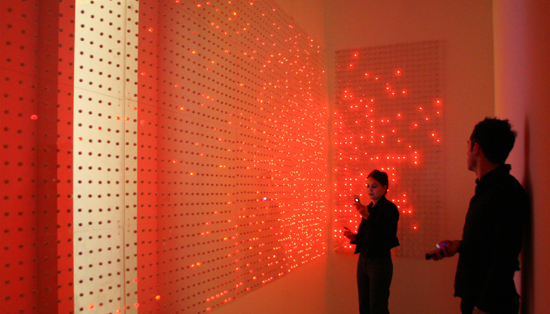Cell Phone Disco2007 / Interactive Mobile Phone InstallationInformationlab (Auke Touwslager, Ursula Lavrenčič)  Cell Phone Disco is a surface that visualizes the electromagnetic field of an active mobile phone. Several thousand lights illuminate when you make or receive a phone call in the vicinity of the installation. Cell Phone Disco makes an invisible property of the environment perceptible to our senses. It reveals the communicating body of the mobile phone. In 2006, architect Ursula Lavrenčič and information designer Auke Touwslager created the first version of Cell Phone Disco, an installation which transforms a part of the electromagnetic spectrum into another frequency range - the range of visible light. Their fascination lies with the transmission quality of the mobile phone; its presence beyond the shell of the device. Every single mobile phone transmits radio waves in order to connect to a network and everyday millions of people around the world are broadcasting their private conversations. Here we are witnessing a unique moment in history, when transmission is no longer the exclusive domain of broadcasting companies. Mobile phone connectivity became just another layer of urban landscape and substantially changed the electromagnetic topography of the environment. Although Cell Phone Disco has been embraced by art galleries and museums, its rightful place is in public space to generate a glimpse at the dynamics of this omnipresent mobile phone traffic. Thousands of sensors that are incorporated in Cell Phone Disco are tuned to detect the mobile phone's electromagnetic radiation. Each of them sets a LED to flicker when it picks up a nearby transmission in frequency used by GSM network. Because each sensor is independent and they are applied in high density, the installation has the capacity to display the real time high-resolution image of the electro magnetic field. As a mirror, it reveals the actual shape of the field and enables us to witness the dynamics of each transmission. Lavrenčič and Touwslager do not label the radiation as good or bad. It is an essential part of the device, as physical and natural as the mobile phone itself. The installation merely provides a missing sense and creates an opportunity to witness it. It is up to the spectator to take a standpoint of his own. As the flickering of the red lights might be experienced as playful or disturbing, the visualization of the electromagnetic body of the mobile phone can fill the spectator with worry or pure fascination. · www.cellphonedisco.org/ Informationlab is a tag that identifies the collaborative efforts of an international group operating at the shifting intersection of art, science, technology & design. Since 2004 Informationlab founders Auke Touwslager (NL) and Ursula Lavrenčič (SLO) have seen their efforts being adopted by different fields and audiences. As a result their Cell Phone Disco (2006) concept found its way to an international art community and their museums and galleries around the world. Most of the group collaboration is based on curiosity driven research which subsequently led to a variety of publications, workshops and lectures. Besides being members of Informationlab both architect Lavrencic and information architect Touwslager run their own design studios in Amsterdam. · www.informationlab.org/ © Informationlab (Ursula Lavrenčič, Auke Touwslager) © Photo by Max Glanville Informationlab (Auke Touwslager, Ursula Lavrenčič), Cell Phone Disco, 2007, Interactive Mobile Phone Installation, approx. 1000 LEDs in plastic strips, sensors, loaned by the artists |
